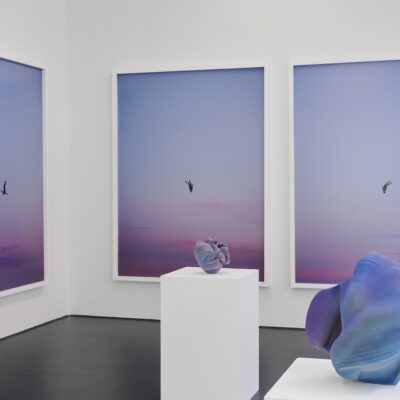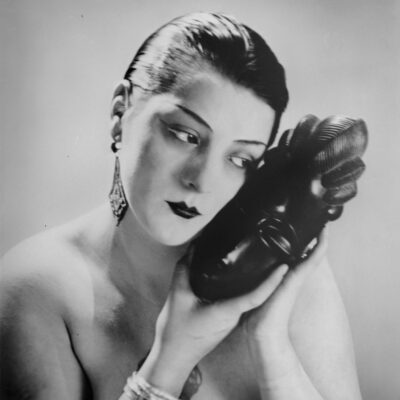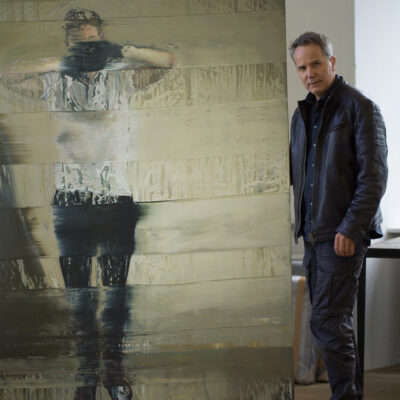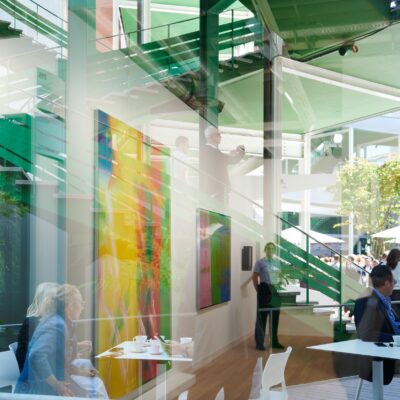Gagosian Geneva has opened its latest exhibit with works by 46-year old Swiss artist Urs Fischer who was born in Zurich and now lives and works in New York. Fischer’s pieces are exhibited and collected by the most well-known contemporary art-lovers, including Peter Brant in Connecticut, Francois Pinault in Venice, Maja Hoffmann in Arles, and Tony Salame in Beirut, as well as at Doha’s airport. In addition, his work is in the collections of major institutions such as Fondation Carmignac, Paris, FRAC Provence-Alpes-Cote d’Azur, Marseille, Kunstmuseum Basel, Migros Museum fur Gegenwartskunst, Zurich, the Museum of Contemporary Art, Los Angeles, and the Museum of Modern Art, New York. He is an art-world superstar on an upwardly projection.
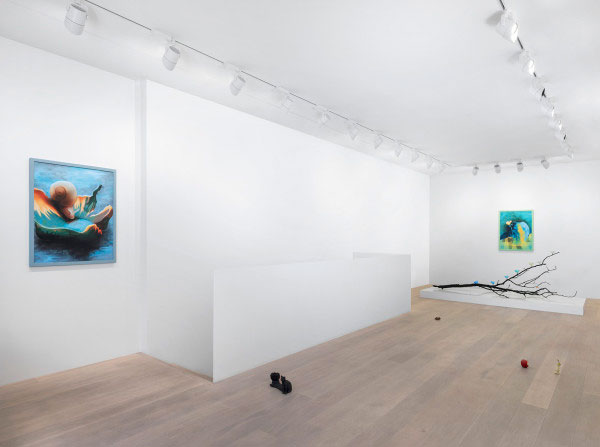
This attention is due to the fact that Urs Fischer’s work is clever and subversive while at the same time, playful and interactive. He is perhaps best-known for his sculptures, and a newly published book titled “Sculptures 2013-1018” provides the impetus for the Geneva exhibition. Fischer has made work ranging from a clay Katy Perry sculpture into which visitors were invited to carve their own “art”, to a Swiss chalet made entirely of loaves of bread. Since 2011, he has created candle sculptures made of wax, with his “Rape of the Sabine Women”, a copy of Giambologna’s sculp- ture melting over an ordinary man, for the Venice Biennale.
Since then, most candle sculptures have been of figures from the art world, for example, Julian Schnabel and Dasha Zhukova, that are lit, burn, melt and drip for the duration of an exhibition. At Gagosian Paris at the moment, Fischer’s much-talked-about “Leo” sculpture of the actor Le- onardo DiCaprio and his parents is burning until December 20th. The pieces represent themes of the passage of time, ageing, death and re-birth, through the destruction of an artwork that is sup- posed to be permanent. Happily for buyers, the melted wax can be re-formed into the original sculpture at a foundry in Switzerland.
While Leo is burning in Paris, at Gagosian Geneva we have an entirely different body of work but one which also questions what is the definition of art. Geneva is sometimes said to be a “bubble”, somewhat separate from the real world, and here, with Fischer’s work, we step into an alternate dimension. A mix of glowing, computer-generated paintings on MDF, and small-scale, fairty-tale sculptures make us feel as if we have fallen down a rabbit hole, like Alice in Wonder- land. As in the story, “If I had a world of my own, everything would be nonsense. Nothing would be what it is, because everything would be what it isn’t.” At Gagosian, we enter a capsule-sized, bizarre world where nothing is as it seems; we have eaten the cake and we are giants.

“Broccoli” is an anthropomorphised pixieish figurine of broccoli on a slab of raw clay. The raw clay is reminiscent of Big Clay 4 featuring giant slabs of piled clay that was shown at Seagrams Plaza in New York in 2015. In this case, the clay slab has been shrunken-down to a toy-sized plaything scattered on the floor of the gallery. Apparently, Fischer didn’t want the small sculptures on plinths in order to make them more playfully accessible. He has used anthropomorphic themes before such as at Gagosian New York with a display of office chairs that rolled and inter- acted with visitors. The chairs had individual “personalities” based on their size and color.
Three other small-scale sculptures dot the floor, making a path for us to carefully trod. “A – Z” is the half-eaten cores of an apple and a pear, in dialogue. Exquisitely-wrought in cast bronze with realistic details, the thinner pear appears to be in a heated discussion with the squat apple. The title “A – Z” can be interpreted in many ways, perhaps as a reference to the life cycle both of fruit and of humans. “Broccoli” and the other two smaller sculptures feature cats which are a recurring motif in Fischer’s work representing an undisciplined, fleeting presence that might participate in an artwork, or may not, but in any case, is unconcerned with what you think it should do. In this way, Fischer plays with the audience, and what we think art should be.
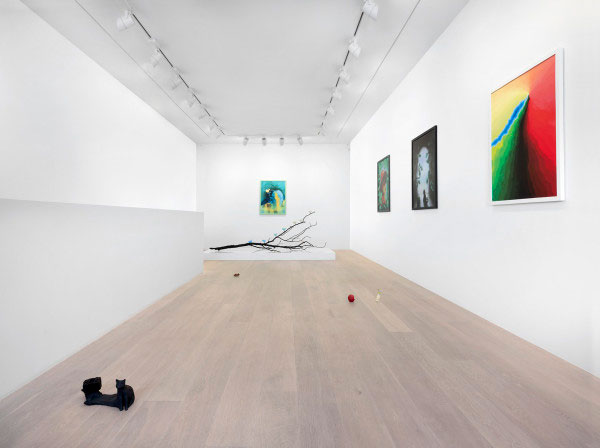
Adding a layer of interest are the six paintings, which reflect and amplify this strange world. Mostly abstract, some have a veneer of Magritte-like surrealism. Fischer created the paintings on a phone and then transferred them via computer onto paper-coated MDF. He said, “Working on the phone, you basically paint with light…You don’t have material constrictions, you can go back and remove stuff…you have freedom…” Many other artists have used iPads or phones including David Hockney whose iPad paintings were shown at London’s Royal Academy in 2012. Child-like simplicity combines with hi-tech machines in these paintings.
All the pieces are painted on gesso to infuse the colors with light. In “Vortex” a spiralling twister whirls into a sinking hole, and pulls us into another dimension. A rainbow-flavoured explosion of colors glow off the paper. “Jump start” is a psychedelically-inspired piece with similarities to Damien Hirst’s spin paintings in its spiralling shape and reliance on technology. Balancing the ab- straction is “Waiting Room” in which the cat motif reappears. The cat peers out from a doorway into a dim landscape while surrealistic leaves reach from the edges. Fischer seems to relish the freedom of painting with light, and by combining it with computerised printing he can teasingly pose the question, what exactly is a painting and how should it be created?

At the center of the gallery is a life-sized tree branch on which half a dozen pastel-coloured birds perch. The branch is a bronze cast of a branch that fell opposite Fischer’s studio, and “it is an anchor, a reality, and it is in the middle of the room.” This realistic sculpture contrasts with the other pieces, and drags us up out of the rabbit hole and back into the real world. The themes of reality versus fantasy, and a playful attitude towards the definition of what is art are characteristic of Fischer’s work. Although perhaps lacking a little of the star-studded glamour of the Parisian “Leo” show, this exhibit, when seen as part of the overall Urs Fischer story so far, is a fascinating insight into his creative world.
This article was first published in November, 2019.
Cet article est aussi disponible en français à https://art-vista.com/le-monde-des-contes-de-fees-durs-fischer-a-gagosian/
